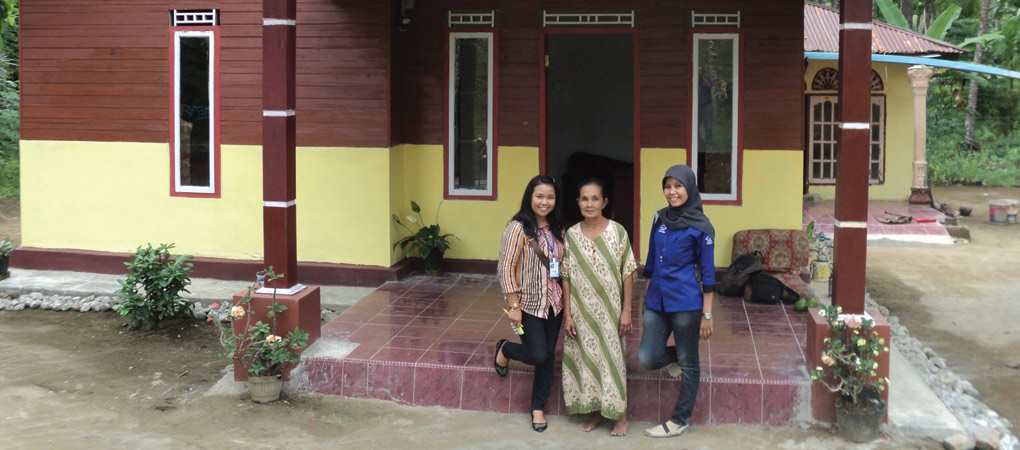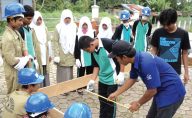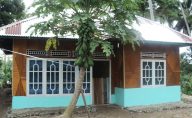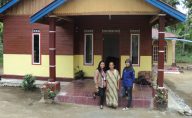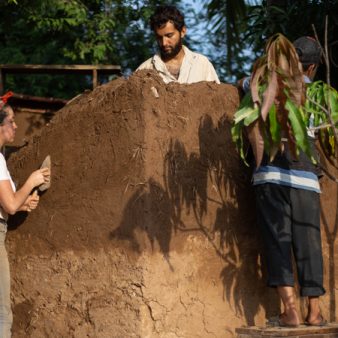The Post-Earthquake Reconstruction project in West Sumatra, Indonesia, was developed by the international non-profit organisation Build Change following the 2007 earthquakes in West Sumatra and Bengkulu, and expanded following the powerful earthquake that destroyed over 200,000 houses in and around Padang in September 2009. At the heart of Build Change’s work is the basic premise that earthquakes do not kill people; poorly built buildings do. It thus strives to greatly reduce deaths and minimise injuries and economic losses from building collapses by designing earthquake-resistant houses and training builders, engineers, homeowners and government officials to build them. It employs a six-step model wherever it works, adapting it as necessary to fit the local situation. In addition to its work in post-disaster reconstruction in Indonesia, Build Change has expanded its activities to China and Haiti.
Project Description
Aims and Objectives
The main purpose of the programme is to reduce the number of deaths, injuries and economic losses from future building collapses in Sumatra’s seismic areas by enabling people to build safe houses now and in the future, through skills training, greater awareness, and access to capital.
Context
West Sumatra is located in the so-called “Pacific Ring of Fire”, one of the most seismically active regions in the world. Every year for the past nine years, the coast off West Sumatra has been the epicentre of a major earthquake measuring 7.0 or more. In September 2009, a powerful 7.6 earthquake destroyed over 200,000 houses in and around Padang, the capital and largest city in the region. Although the number of lives lost and severely injured was less than 2,500, over one million people were affected through total or partial loss of their homes and livelihoods.
Rapid urbanisation and increasing wealth over recent decades have led to changing construction patterns, with a move away from flexible, wooden structures to the more brittle confined masonry, which can be deadly in an earthquake if not well designed and built. Surveys have shown that houses with no earthquake-safe properties suffered five times more damage and were ten times more likely to collapse during earthquakes in the area. The Indonesian government provides US$1,700 towards reconstruction costs for homes that have been damaged, but this accounts for only 30 to 50 per cent of the funds that people need to build a safe home and many homes are therefore left uncompleted. While donor-driven models can and do build safe houses, they miss the opportunity to build local capacity, and in many cases the houses built after the funding and technical assistance cease are not built to those same safe standards.
Key Features
- Build Change (formerly “Center for Earthquake Resistant Houses”) is an international non-profit organisation incorporated in the USA in 2004. It was founded by Dr Elizabeth Hausler Strand, a skilled brick, block and stonemason with a PhD in civil engineering who, whilst conducting research in India and Iran, found that small, affordable changes in construction techniques could save lives. At the heart of Build Change’s work is the basic premise that earthquakes do not kill people; poorly built buildings do. It thus strives to greatly reduce deaths and minimise injuries and economic losses from building collapses by designing earthquake-resistant houses and training builders, engineers, homeowners and government officials to build them.
- It employs a six-step model wherever it works, adapting it as necessary to fit the local situation. The model involves learning from previous earthquake experience in the area; designing minor, low or no-cost changes to existing ways of building; building local skills; stimulating local demand; facilitating access to capital and measuring the change. It is estimated that 60 per cent of homeowners are meeting the minimum standards necessary to withstand future earthquakes using Build Change’s guidance.
- The main components of the current programme in Padang, West Sumatra include:
- Advocating for and training people to build timber-framed houses with masonry skirt walls, or safe confined masonry houses if that is what the homeowner wants. Besides being less resilient during an earthquake if built incorrectly, masonry houses are also more expensive to build, harder to build correctly and harder to correct if major mistakes are made during construction.
- Providing hands-on technical assistance to homeowners for rebuilding their houses lost in the earthquake and raising their awareness of safe building techniques.
- Providing on-the-job training and technical support to builders as they construct earthquake-safe houses.
- Building a pipeline of professionals trained in earthquake-safe techniques by building the capacity and mentoring technical high school teachers and their students in West Sumatra and beyond.
- Undertaking a range of publicity activities in order to help spur demand for safe building practices, and thus help to maintain a flow of work for those trained in safe construction methods.
In order to implement this programme, Build Change has worked in partnership with Indonesian and international engineers and architects, who helped develop the housing designs and guidelines used, as well as with pro bono structural engineers and university departments who helped with testing building materials. It has further collaborated with major international relief agencies, training 100 of their technical supervisors. In the six months following the 2009 earthquake, it partnered with the Emergency Capacity Building Consortium with funding from USAID OFDA to provide technical assistance and training to homeowners and technical supervisors.
What impact has it had?
- Build Change has provided hands-on technical assistance to 610 homeowners and has raised the awareness of another 4,958 homeowners regarding safe building techniques. Through its collaborative work, 12,878 homes have been improved directly or indirectly, representing over 50,000 people living in safer homes.
- Build Change has taught the fundamentals of earthquake-resistant construction to over 5,000 people across the building chain, with on-the-job training and technical support provided to 1,085 builders and 3,293 engineers to date. Furthermore, 146 teachers and 3,012 students have been trained in earthquake-safe techniques and progress is well underway to getting the course institutionalised by the Bureau of Education.
- None of the 478 houses built to the minimum Build Change standards following the September 2007 earthquakes suffered any damage in the 2009 earthquake.
- In partnership with government officials and local academics, Build Change successfully lobbied the central government to allow confined masonry and timber frame with a masonry skirt wall, and to discourage donors and relief agencies from promoting short-term solutions.
- Major international relief agencies have come to trust Build Change’s capacity to deliver valuable technical information and training to ensure their own projects meet earthquake-resistant guidelines. To date, the organisation has trained 100 of their technical supervisors.
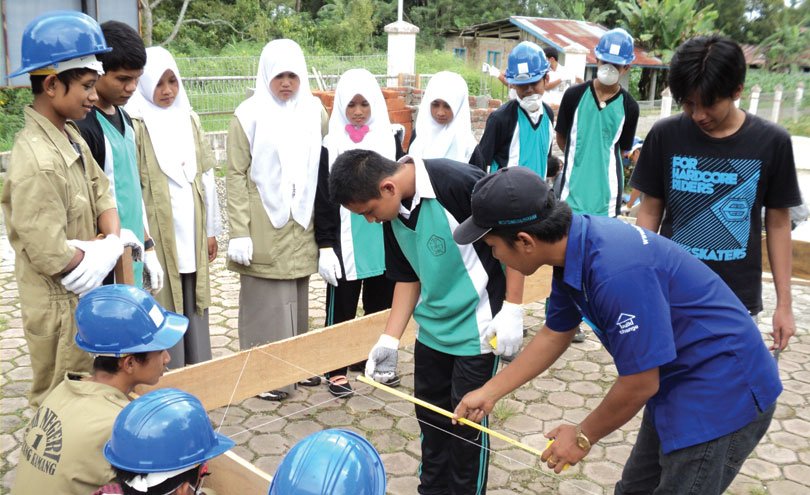
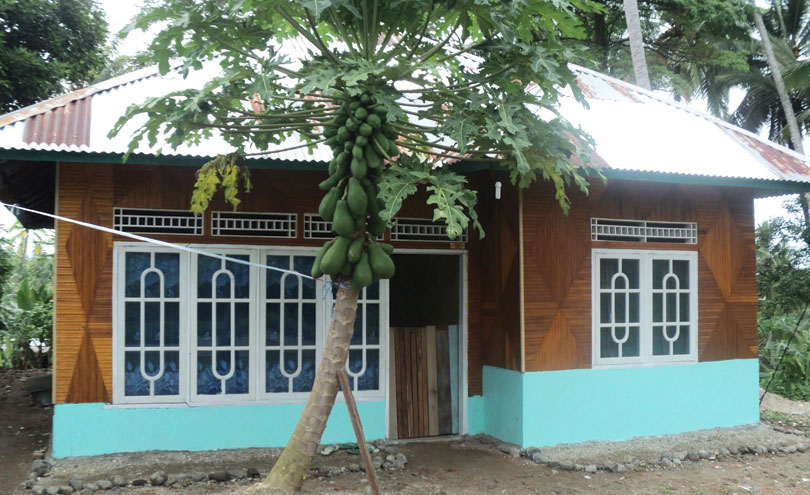
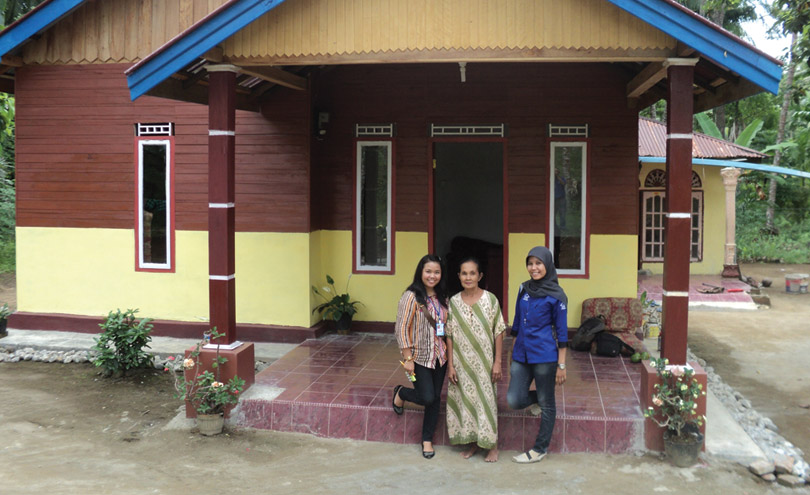
How is it funded?
Build Change works directly with homeowners who are rebuilding using a government cash grant (US$1,700) and their own funds. Its own costs (staffing, office space, transport, cameras, school programmes, booklets and other marketing materials) are covered by grants, crowd funding, or payments for training services provided. Grants come from the Hilti Foundation and Caterpillar Foundation and income has been earned from six NGOs for training services. Build Change continues to pursue both private and public funding for longer-term programme coverage and expansion.
Why is it innovative?
- Rather than the usual, donor-driven, one-size-fits-all model for housing reconstruction, the Build Change team provides hands-on technical assistance directly to the homeowners, who choose the house type appropriate to their lifestyle, family size and budget and can oversee that the quality of workmanship and materials is good from builders that they are paying to carry out the rebuilding.
- By working across the whole building industry, Build Change comprehensively improves knowledge, skills, systems, and quality practices for earthquake-safe construction.
- The organisation uses a range of communication methods to inform a wider audience about earthquake-resistant design and construction.
- It seeks to change construction practice permanently, recognising that earthquake-resistant housing construction will only become common if the right technology is locally available, widely known, culturally accepted, and competitively priced.
What is the environmental impact?
When homeowners are empowered to make their own choices about design and construction, they typically build only what they need. Not only do they waste less, they also reuse and recycle more. For example, many homeowners are reusing windows, doorframes and structural timber from their old house, as well as bricks.
Although the timber framed buildings use a significant amount of timber, people reuse timber from their damaged house, have access to coconut palms on their plots or can purchase it from local sources. In addition, Build Change is investigating ways of firing bricks at higher temperatures than is currently feasible with rice husks, to make them stronger while also keeping costs low and reducing CO2 emissions.
Is it financially sustainable?
A 36 m2 timber frame with masonry skirt wall house costs approximately US$3,000, while the equivalent for confined masonry is US$8,000. Over 93 per cent of the homeowners rebuilding with the timber-frame houses are able to build a house that meets the minimum safety standards using only government funds; only 52 per cent built from confined masonry do.
By working across the building chain on both the supply and demand sides, Build Change ensures that building safe houses becomes the norm. People trained to offer quality workmanship and materials will therefore be offered more job opportunities and will be able to command higher pay. This is all the more so since West Sumatra sits in an extremely active seismic zone, where earthquake-resistant houses will always be needed.
Indonesian staff implements the programme in its entirety. Build Change recruits and mentors local construction professionals who provide hands-on design and construction assistance directly to homeowners and builders.
The costs of supporting Build Change’s work continue to be met from a mix of social enterprise income and grant aid. Given the nature of their work in areas that have experienced natural disasters, emergency donor aid is typically available.
What is the social impact?
The main purpose of the project is to ensure people’s safety in the event of an earthquake and this is achieved through training activities, building inspections ensuring that standards are complied with, communication activities, publications and research into improved and affordable building methods.
Build Change increases the skills and abilities of multiple actors across the building chain. It recruits and mentors local construction professionals to provide hands-on design and construction assistance directly to homeowners and builders. It trains Indonesian vocational teachers to equip the next generation of building professionals with the knowledge and skills they will need to build earthquake-resistant houses. Many of these vocational teachers have become strong advocates in the community for safe building practices.
The training programmes provided by Build Change in the aftermath of the earthquake help to bring the community together and the ongoing reconstruction work further cements community linkages.
By breaking the cycle of ongoing expenditure on the repair and rebuilding of homes, Build Change is able to improve the overall economic position of those on low incomes. By empowering homeowners to make their own decisions regarding construction, it enables people to gain confidence to engage more actively in society.
Barriers
- This project targets primarily homeowners who already possessed a plot of land and a house prior to the earthquake.
- As the current government grant of US$1,700 remains insufficient, homeowners’ lack of funds means that they either do not complete their home, or complete them without meeting minimum standards. This is exacerbated by the fact that commercial banks will only give loans to those with formal sector jobs and significant collateral. Whilst funding remains a challenge, Build Change has sourced additional funds to act as incentives for households to build to the minimum safety standard and is furthermore now looking to access micro-finance loans with Mercy Corps.
- The conventional response of relief agencies focuses on short-term solutions, which leads to fewer resources for permanent housing. Build Change thus focuses on promoting the homeowner-driven model among relief agencies
Lessons Learned
- It is easier to make minor, low or no-cost changes to existing ways of building than introduce a completely new technology, or reintroduce a traditional building method that has gone out of style.
- The technology must be compliant with standards, built with locally available materials and labour, and built with quality workmanship and materials, and the costs must be competitive with local building methods. If it is too high, homeowners cannot afford it.
- Everyone in the building chain must be part of the solution. A good design will not make a house safe; a builder needs to be trained to do quality work and a material supplier to make quality materials before a home can be safe from collapse during earthquakes. If inspecting houses is too time-consuming or difficult, enforcement will be spotty or non-existent, therefore inspection systems need to be simple and easy-to-use.
- Both supply and demand need to be met for change to be sustainable.
Evaluation
Monitoring and evaluating impact are key elements of Build Change’s approach. Key indicators measured are whether governments develop, implement and enforce safe building standards and designs; the number and degree to which actors are instilled with the knowledge of safe-building techniques and the number and degree to which homeowners build safer homes. In addition, Build Change used its expertise and that of other experts to determine where trade-offs could be made in design or materials that were less expensive but provided the same or better level of safety. The information also formed the basis for a pilot study focused on financial incentives as a motivation for a homeowner to meet minimum standards.
Transfer
After the 2007 earthquakes in West Sumatra, Build Change scaled up both the size and scope of its programme. It was requested by relief agencies to train their staff to enable them to build earthquake-safe houses correctly on a large scale. It expanded to China after the May 2008 earthquake in Sichuan, and to Haiti after the January 2010 earthquake struck Port-au-Prince, using the same six-step model but adapting or creating other resources, guidelines, housing designs, and training courses to fit the local situation.
In Sichuan, China, Build Change has trained 269 builders and engineers, and provided technical assistance to over 1,300 homeowners as they rebuilt their earthquake-resistant houses. The organisation worked with the local government on building codes and enforcement, and now provides training courses to technical college students and government officials throughout the country.
In Haiti, Build Change continues to provide support to government agencies through training and developing standards and guidelines for the most common building structures and retrofits, and runs ongoing builder and homeowner training programmes. To date, 57 engineers from the Ministry of Public Works have been trained in retrofit techniques and 1,530 builders and engineers and 3,120 homeowners in safe building techniques. In addition, Build Change has partnered with Cordaid and J/P Haitian Relief Organisation to provide technical support and supervision on the retrofit or new construction of 1,500 homes so far; is working with building material providers to improve the quality of construction blocks; and co-developing a “House of Knowledge” resource centre with Cordaid.

